Abstract
The purpose of this study was to assess the effect of a 735-kV transmission line on the electric and magnetic field exposures of people living at the edge of the line's right of way. Exposure of 18 adults, mostly white-collar workers, living in different bungalows located 190-240 feet from the line (exposed subjects) was compared to that of 17 adults living in similar residences far away from any transmission line. Each subject carried a Positron meter for 24 hr during 1 workday, which measured 60-Hz electric and magnetic fields every minute. All measurements were carried out in parallel for exposed and unexposed subjects during the same weeks between September and December. During measurements the average loading on the line varied between 600 and 1100 A. The average magnetic field intensity while at home was 4.4 times higher among exposed subjects than unexposed (7.1 versus 1.6 mG, p = 0.0001) and 6.2 times higher when considering only the sleeping period (6.8 versus 1.1 mG, p = 0.0001). Based on the 24-hr measurement, average magnetic field exposure was three times higher among the exposed. Electric field intensity was also higher among the exposed while at home (26.3 versus 14.0 V/m, p = 0.03). Magnetic field intensity among the exposed was positively correlated with the loading on the line (r = 0.8, p = 0.001). Percentage of time above a magnetic field threshold (2 mG or 7.8 mG) was a good indicator to distinguish the two types of exposure.(ABSTRACT TRUNCATED AT 250 WORDS)
Full text
PDF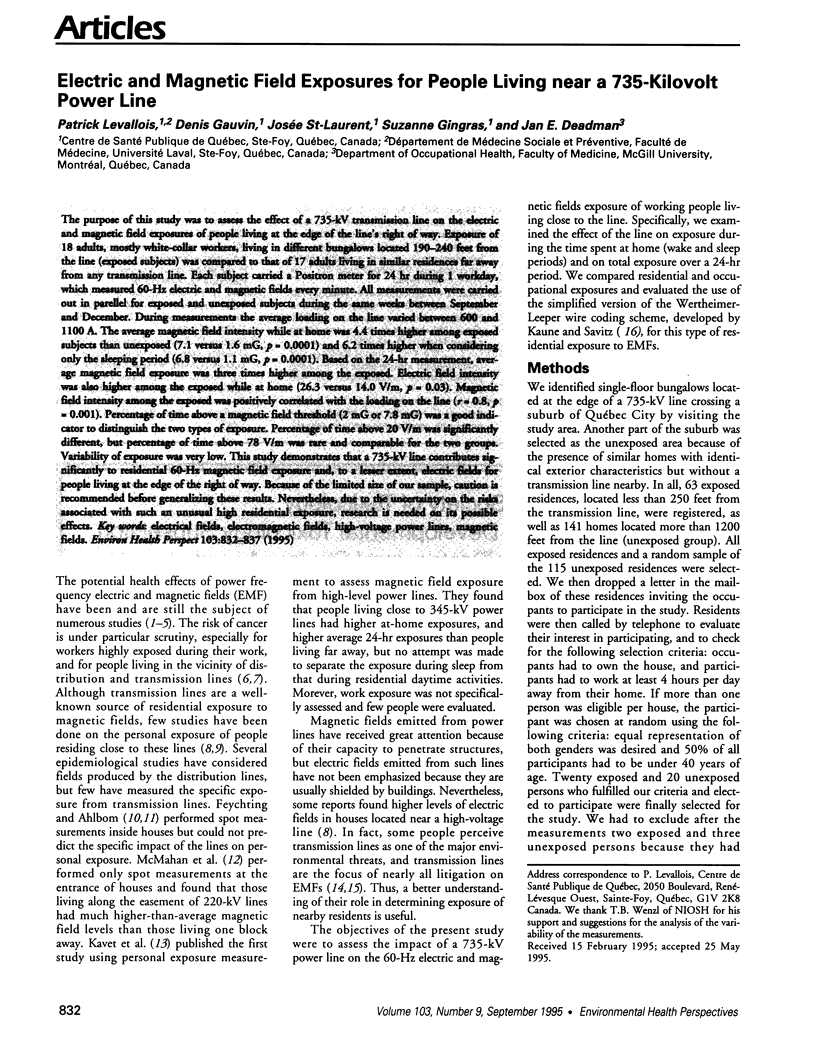
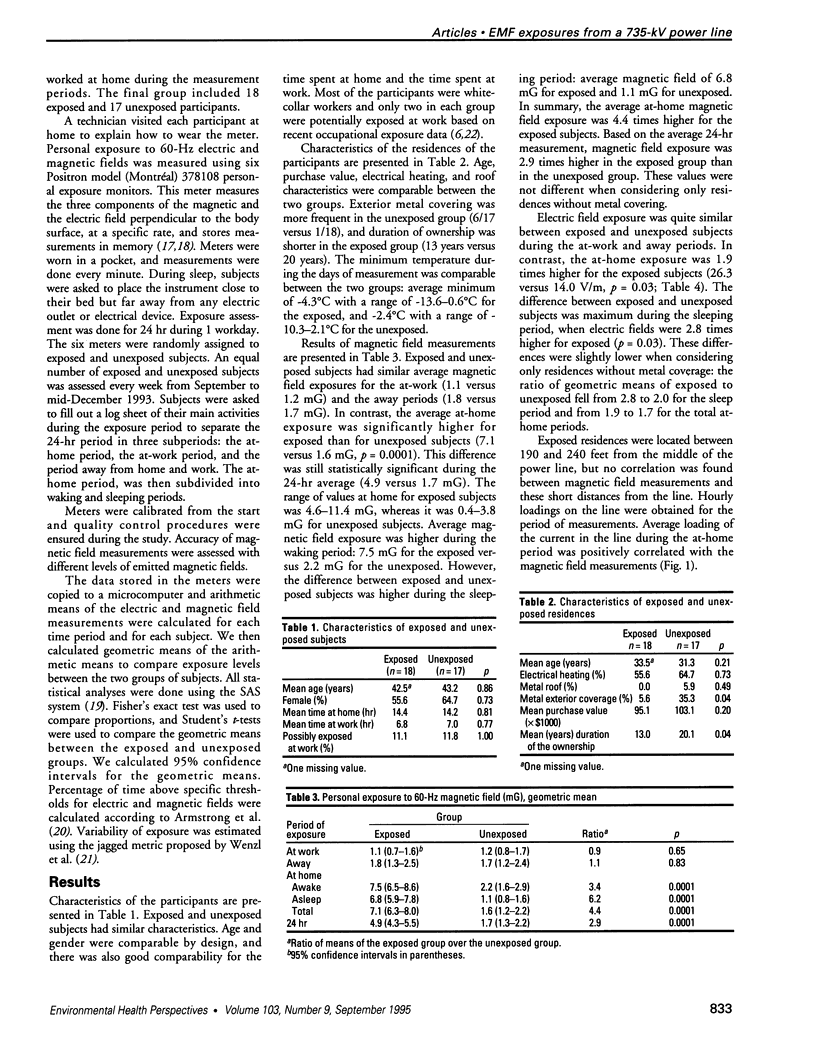
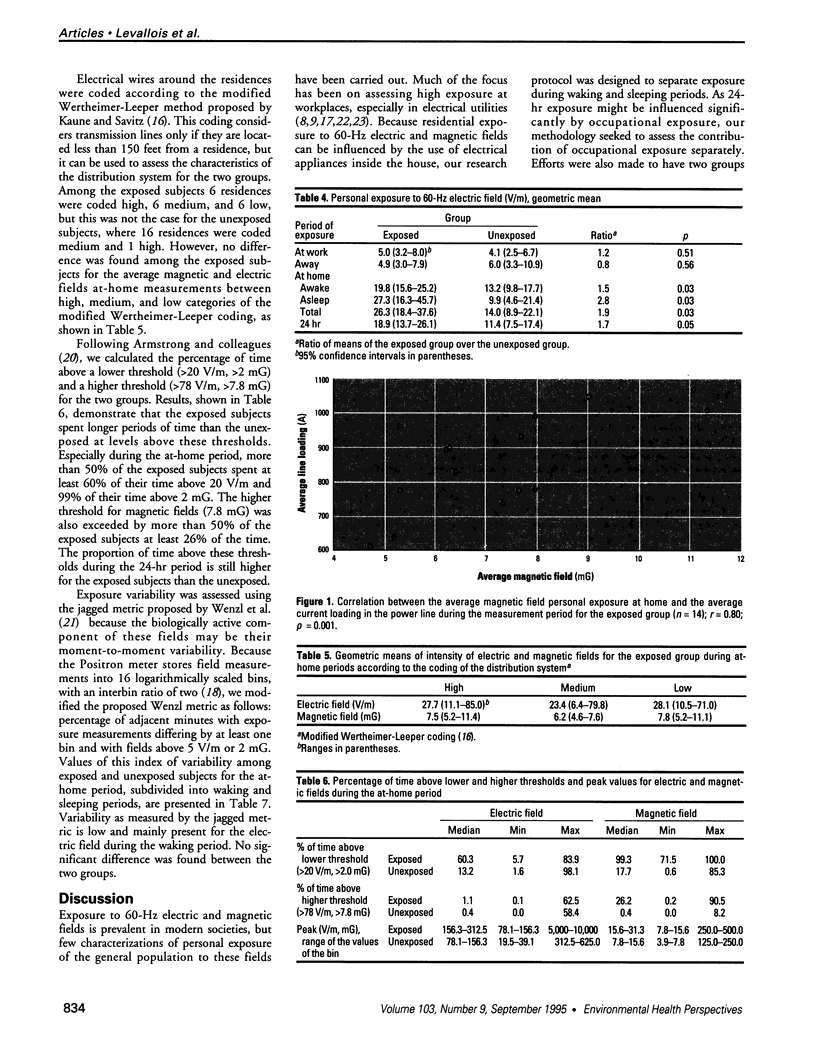
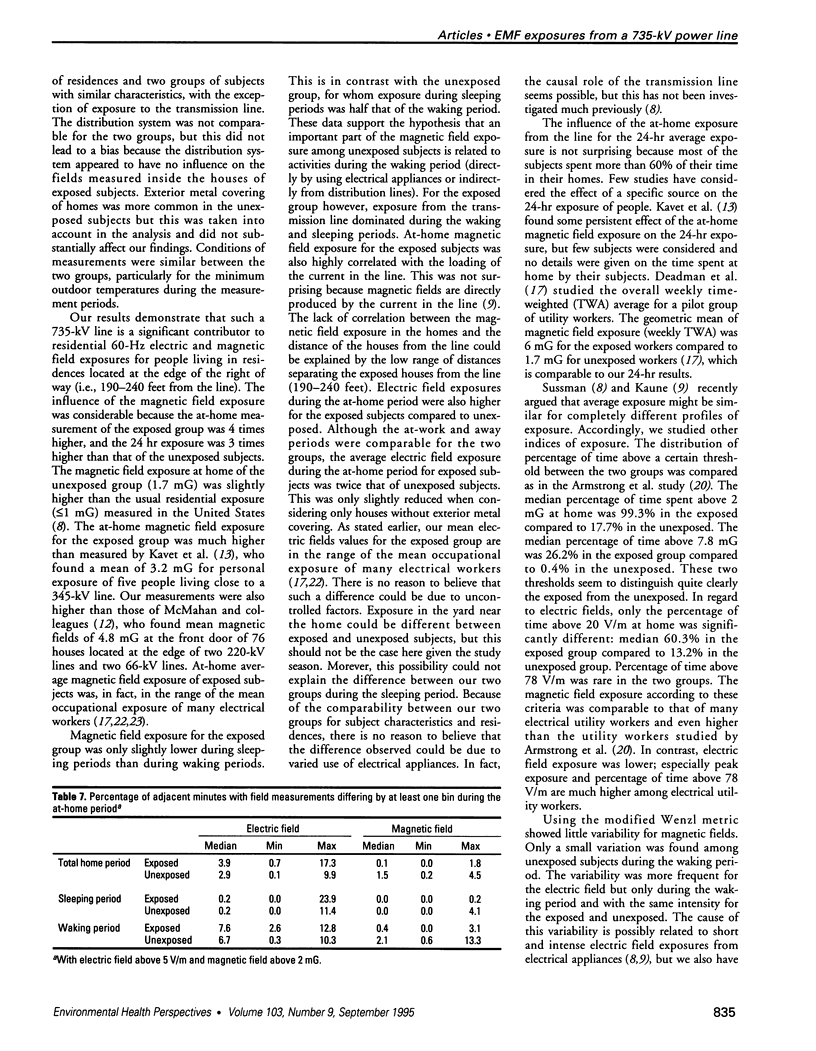
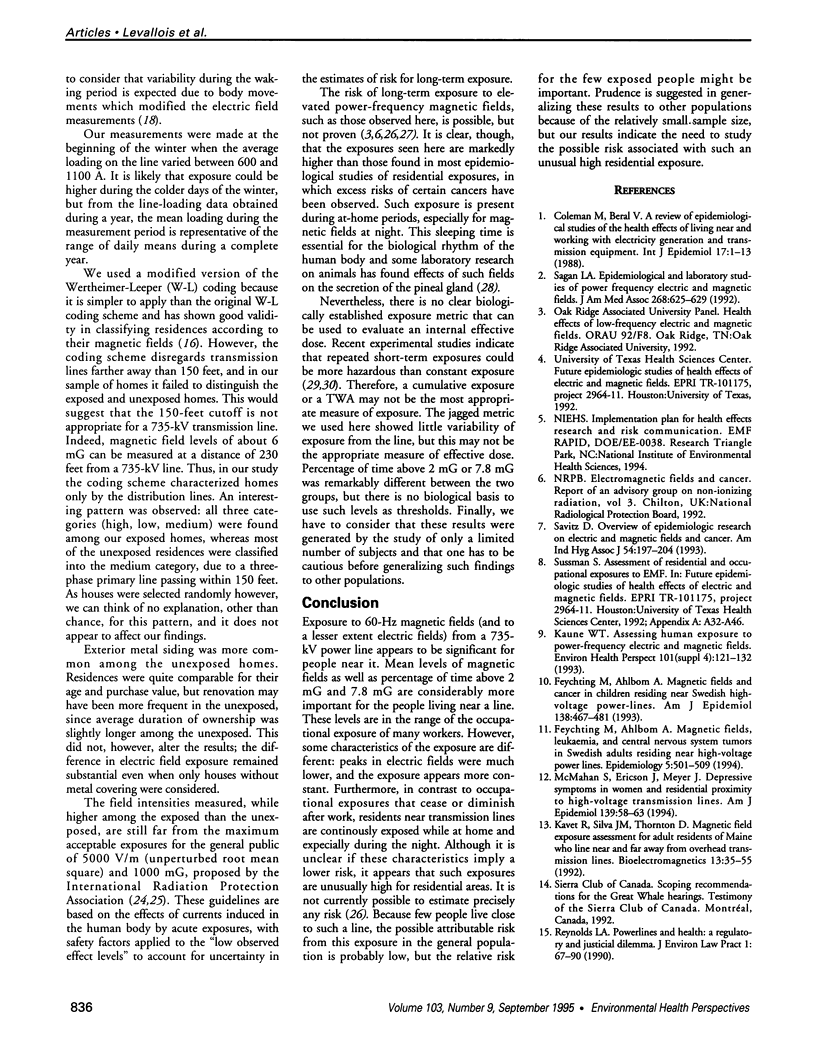
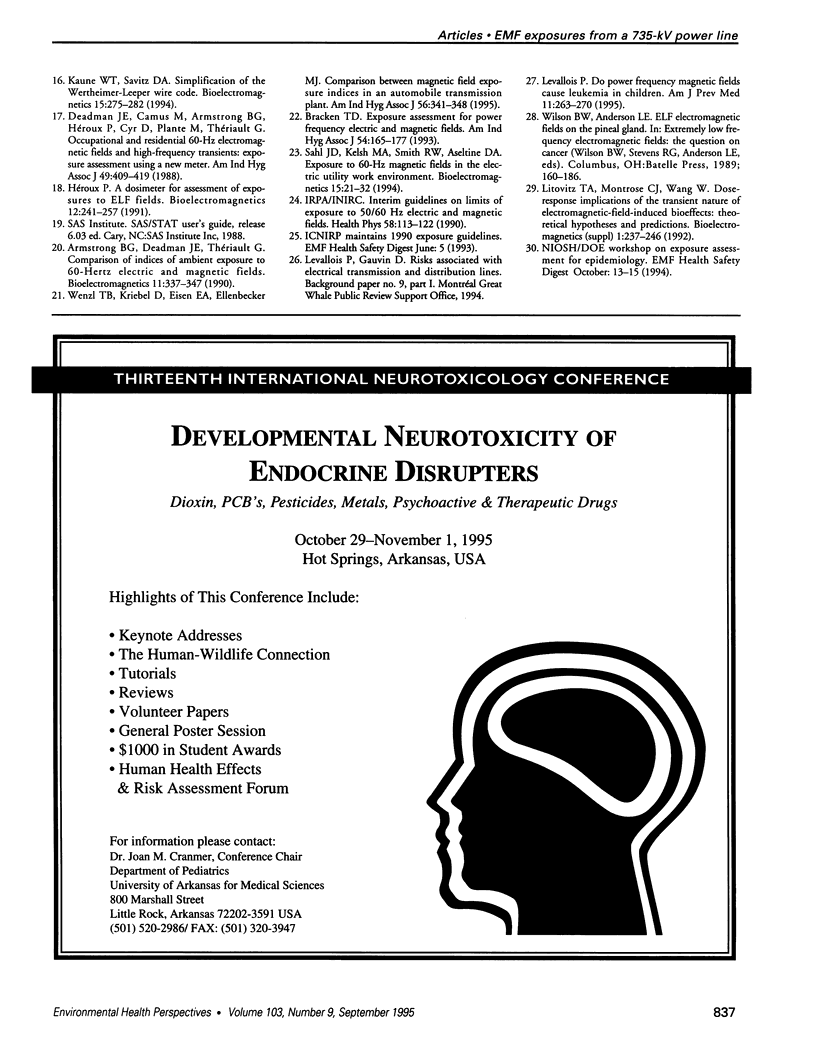
Images in this article
Selected References
These references are in PubMed. This may not be the complete list of references from this article.
- Armstrong B. G., Deadman J. E., Thériault G. Comparison of indices of ambient exposure to 60-hertz electric and magnetic fields. Bioelectromagnetics. 1990;11(4):337–347. doi: 10.1002/bem.2250110408. [DOI] [PubMed] [Google Scholar]
- Bracken T. D. Exposure assessment for power frequency electric and magnetic fields. Am Ind Hyg Assoc J. 1993 Apr;54(4):165–177. doi: 10.1080/15298669391354522. [DOI] [PubMed] [Google Scholar]
- Coleman M., Beral V. A review of epidemiological studies of the health effects of living near or working with electricity generation and transmission equipment. Int J Epidemiol. 1988 Mar;17(1):1–13. doi: 10.1093/ije/17.1.1. [DOI] [PubMed] [Google Scholar]
- Deadman J. E., Camus M., Armstrong B. G., Héroux P., Cyr D., Plante M., Thériault G. Occupational and residential 60-Hz electromagnetic fields and high-frequency electric transients: exposure assessment using a new dosimeter. Am Ind Hyg Assoc J. 1988 Aug;49(8):409–419. doi: 10.1080/15298668891379981. [DOI] [PubMed] [Google Scholar]
- Feychting M., Ahlbom A. Magnetic fields and cancer in children residing near Swedish high-voltage power lines. Am J Epidemiol. 1993 Oct 1;138(7):467–481. doi: 10.1093/oxfordjournals.aje.a116881. [DOI] [PubMed] [Google Scholar]
- Feychting M., Ahlbom A. Magnetic fields, leukemia, and central nervous system tumors in Swedish adults residing near high-voltage power lines. Epidemiology. 1994 Sep;5(5):501–509. [PubMed] [Google Scholar]
- Héroux P. A dosimeter for assessment of exposures to ELF fields. Bioelectromagnetics. 1991;12(4):241–257. doi: 10.1002/bem.2250120405. [DOI] [PubMed] [Google Scholar]
- Kaune W. T. Assessing human exposure to power-frequency electric and magnetic fields. Environ Health Perspect. 1993 Dec;101 (Suppl 4):121–133. doi: 10.1289/ehp.93101s4121. [DOI] [PMC free article] [PubMed] [Google Scholar]
- Kaune W. T., Savitz D. A. Simplification of the Wertheimer-Leeper wire code. Bioelectromagnetics. 1994;15(4):275–282. doi: 10.1002/bem.2250150402. [DOI] [PubMed] [Google Scholar]
- Kavet R., Silva J. M., Thornton D. Magnetic field exposure assessment for adult residents of Maine who live near and far away from overhead transmission lines. Bioelectromagnetics. 1992;13(1):35–55. doi: 10.1002/bem.2250130106. [DOI] [PubMed] [Google Scholar]
- Levallois P. Do power frequency magnetic fields cause leukemia in children? Am J Prev Med. 1995 Jul-Aug;11(4):263–270. [PubMed] [Google Scholar]
- Litovitz T. A., Montrose C. J., Wang W. Dose-response implications of the transient nature of electromagnetic-field-induced bioeffects: theoretical hypotheses and predictions. Bioelectromagnetics. 1992;Suppl 1:237–246. doi: 10.1002/bem.2250130721. [DOI] [PubMed] [Google Scholar]
- McMahan S., Ericson J., Meyer J. Depressive symptomatology in women and residential proximity to high-voltage transmission lines. Am J Epidemiol. 1994 Jan 1;139(1):58–63. doi: 10.1093/oxfordjournals.aje.a116935. [DOI] [PubMed] [Google Scholar]
- Sagan L. A. Epidemiological and laboratory studies of power frequency electric and magnetic fields. JAMA. 1992 Aug 5;268(5):625–629. [PubMed] [Google Scholar]
- Sahl J. D., Kelsh M. A., Smith R. W., Aseltine D. A. Exposure to 60 Hz magnetic fields in the electric utility work environment. Bioelectromagnetics. 1994;15(1):21–32. doi: 10.1002/bem.2250150107. [DOI] [PubMed] [Google Scholar]
- Savitz D. A. Overview of epidemiologic research on electric and magnetic fields and cancer. Am Ind Hyg Assoc J. 1993 Apr;54(4):197–204. doi: 10.1080/15298669391354559. [DOI] [PubMed] [Google Scholar]
- Wenzl T. B., Kriebel D., Eisen E. A., Ellenbecker M. J. Comparisons between magnetic field exposure indices in an automobile transmission plant. Am Ind Hyg Assoc J. 1995 Apr;56(4):341–348. doi: 10.1080/15428119591016953. [DOI] [PubMed] [Google Scholar]



